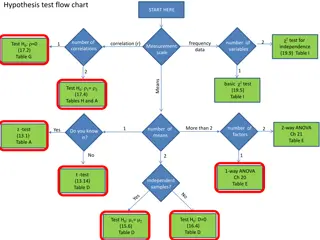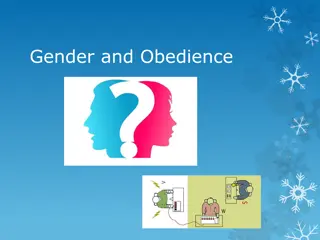College Transition Planning for Students with Learning Differences
Explore transition planning for students with learning differences like dyslexia, dyscalculia, dysgraphia, auditory and visual processing disorders, and nonverbal learning disabilities. Understand executive functioning challenges and characteristics of ADHD in educational settings.
4 views • 37 slides
Learning Intentions: We will learn how to compare songs and poems. We will use comparative language to show similarities and differences.
Explore the art of comparing songs and poems, using comparative language to highlight similarities and differences. Dive into Venn diagrams, linking words, and key terms to analyze genres like Reggae, Irish Ballads, and Rap music.
0 views • 10 slides
Introduction to Difference in Differences Using Stata
Learn about Difference in Differences analysis using Stata with Chuck Huber at the Indian Stata Conference. The presentation covers the conceptual introduction, parallel trends assumption, and more using practical examples and panel data. Download slides and resources for further exploration.
3 views • 93 slides
Exploring Magnetism: Properties, Differences, and Similarities
Discover the properties of magnets and magnetic materials, understand the differences and similarities between permanent magnets and electromagnets. Delve into the basics of magnetism, explore magnetism stations, hypothesize about magnetic attraction, and learn interesting facts about magnets. Engag
3 views • 18 slides
Federal Learning Account Program: Enhancing Individual Training Rights
Explore the Federal Learning Account Program focusing on individual training rights, including the right to an individual training plan, sectors with collective bargaining agreements on education, and employer responsibilities in providing training opportunities. Discover practical tips for particip
2 views • 34 slides
Pediatric Cardiovascular Exam Overview
Explore the differences between pediatric and adult cardiovascular exams, highlighting key differences in disease patterns, examination approaches, and objectives. Learn about the importance of distinguishing between routine well-baby exams and evaluations of ill children, along with step-by-step gu
6 views • 24 slides
RPO Companies vs. Traditional Recruitment Agencies_ Key Differences
RPO Companies vs. Traditional Recruitment Agencies_ Key Differences
0 views • 3 slides
Understanding The Differences Between Hourly Care and Live-In Care
Choosing the right type of Home Health Aide NJ for your loved one can be challenging. Whether you need occasional support or constant supervision, understanding the differences between hourly care and live-in care is crucial for making the best decision.\n\nFor more info visit: \/\/carebridge.care\/
1 views • 6 slides
Differences Between Primary and Permanent Teeth Explained
Dive into the distinctions between primary (baby) and permanent teeth presented by Dr. Ganga Dubey. Explore general variances, eruption sequences, crown characteristics, and histological differences. Understand individual variations in tooth morphology for a comprehensive comparison.
0 views • 39 slides
Importance of Maintaining Individual Rights in Effective Care
Recognizing and upholding an individual's rights is crucial for providing effective care. It ensures the individual feels respected, valued, and supported, contributing to a trusting relationship. Failure to meet these rights can lead to negative consequences impacting the individual's well-being an
0 views • 32 slides
Understanding Individual Employment Plan (IEP) and Individual Service Strategy (ISS) in WIOA Training Academy
Individual Employment Plan (IEP) and Individual Service Strategy (ISS) are essential components of the WIOA Training Academy, tailored to meet the career needs of participants under various WIOA programs. IEPs focus on personalized career services for adults and dislocated workers, while ISSs are sp
1 views • 23 slides
Understanding Analysis of Variance (ANOVA) for Testing Multiple Group Differences
Testing for differences among three or more groups can be effectively done using Analysis of Variance (ANOVA). By focusing on variance between means, ANOVA allows for comparison of multiple groups while avoiding issues of dependence and multiple comparisons. Sir Ronald Fisher's ANOVA method provides
0 views • 28 slides
Overview of Performance Management Systems and Competency Mapping
Performance Management Systems (PMS) play a crucial role in ensuring organizational objectives are met through individual contributions. This entails continuous improvement at all levels - individual, team, and organizational. Managing performance is vital for survival and growth in a competitive en
3 views • 45 slides
Influences of Individual Characteristics on Health: A Critical Exploration
This session delves into the various influences on health at an individual level, examining factors such as developmental, social, and psychological elements. It explores the impact of foetal development, teratology, and foetal programming on long-term health outcomes, emphasizing the intricate rela
0 views • 20 slides
Sociology and Psychology in Public Health: Exploring Common Links and Differences
Sociology and psychology intersect in public health studies, examining individual behavior and social structures. Commonalities include dedicated subfields for health and illness research, while differences lie in focus areas. Discover the impact of sociology in public health, historical contributio
0 views • 92 slides
Understanding Fundamental Rights in the Indian Constitution
Fundamental rights are crucial for developing an individual's personality and dignity in society. The Indian Constitution grants six fundamental rights, including equality, freedom, and protection against exploitation. Despite certain limitations, these rights are essential for upholding individual
0 views • 10 slides
Understanding Human Nature and Individual Differences in Foundation of Human Skills
Explore the foundational concepts of human behavior, individual differences, and organizational culture in the study of human skills. Delve into topics such as human nature, personality, attitudes, intelligence, and learning in Prof. Muskan Jeswani's course. Understand the significance of inter- and
0 views • 11 slides
Understanding Symbolic Interactionism in Sociology
Symbolic Interactionism is a school of thought in sociology that focuses on how individuals interact with each other through symbols, shaping social structures. It highlights the role of symbols in defining actions and meanings in social interactions. The concept explores how different socializing e
0 views • 18 slides
Understanding Effective Communication in Different Contexts
Explore the elements of the transactional model of communication, complexities of communication, individual differences in preferences, effective communication strategies, and the impact of technology in the workplace. Dive into various communication scenarios like team meetings, conflict resolution
0 views • 9 slides
Understanding the Development of Fears: Individual and Parental Influences
Exploring the impact of individual characteristics and parental dispositions on learned animal fears, this study delves into the prevalence of phobias, the development of fears and phobias, fears through the transmission of information, and the role of these factors in childhood fear acquisition. Th
0 views • 23 slides
Methods to Evaluate Benefit-Risk Trade-Off in Individual Patients
Evaluating benefit-risk trade-offs in individual patients is crucial for making informed treatment decisions, especially when safety concerns arise with new therapies. This involves developing statistical algorithms to identify cases where potential harm outweighs benefits, as illustrated in the TRA
0 views • 26 slides
Understanding Sensory Processing and Relationships: Exploring Individual Differences
Explore the intricate connections between sensory processing and behavioral responses, delving into how individual variations in sensory patterns can impact relationships, engagement, and daily routines. Gain insights into the significance of sensory experiences in nurturing brain function, and lear
0 views • 29 slides
Exploring Sequences and Patterns in Mathematics
Dive into the world of sequences and patterns by exploring expressions, common differences, and nth terms. Discover how to create sequences with specific common differences, identify terms within sequences, and use Venn diagrams to visualize different scenarios. Uncover the rules for constructing nt
0 views • 13 slides
Advanced Techniques in Relational Data Outlier Detection
This document delves into cutting-edge methods for outlier detection in relational data, focusing on profile-based and model-based approaches such as leveraging Bayesian networks, feature generation, and individual feature vector summarization. The examples provided showcase the application of these
1 views • 30 slides
Debating Alternatives to the Individual Mandate in Healthcare Reform
Recent bipartisan discussions have called for exploring alternatives to the individual mandate in healthcare, citing its unpopularity and criticisms of being coercive or ineffective. The industry supports the mandate but believes it should be better enforced. Studies suggest that eliminating the man
0 views • 16 slides
Analyzing Inequality Trends Using NTA at Individual Level
NTA (National Transfer Accounts) methodology is utilized to measure levels and trends in inequality at the individual level by adjusting age profiles and estimating adjustment factors. By studying distributions of individual outcomes and exploring factors contributing to inequality, questions like t
0 views • 44 slides
Exploring Personality Types and Traits - IPE.MDY.ZONE.2020
Personality types and traits play a significant role in shaping an individual's behavior, thinking patterns, and relationships. This content delves into the primary personality types - Dominance, Inducement, Compliance, and Steadiness - highlighting their characteristics and the Type A and Type B pe
0 views • 28 slides
Gender Differences in Obedience Studies
Research studies on gender differences in obedience reveal varying levels of obedience between men and women. While some studies show similarities in obedience levels, others suggest potential differences attributed to factors like empathy and assertiveness. Contradictory findings exist, with some s
0 views • 9 slides
Discussion on IEEE 802.11 Group vs. Individual Epochs
Trigger discussion on differences between group and individual epochs in IEEE 802.11 standards. Group epochs involve simultaneous transitions of MAC parameters by all or selected STAs based on AP trigger, while individual epochs allow each STA to independently change its parameters. Key points inclu
0 views • 4 slides
Variability in Training Duration for Acquiring Absolute Pitch Ability
Sakakibara's study on acquiring absolute pitch ability revealed significant variability in the time taken by participants to pass pitch identification tests. Genetic predisposition may play a role, as differences were observed independent of factors like age, gender, and music experience. The study
0 views • 17 slides
Understanding Network Analysis: Whole Networks vs. Ego Networks
Explore the differences between Whole Networks and Ego Networks in social network analysis. Whole Networks provide comprehensive information about all nodes and links, enabling the computation of network-level statistics. On the other hand, Ego Networks focus on a sample of nodes, limiting the abili
0 views • 31 slides
Evaluating Differences Between Psychedelic Drug Users and Non-Psychedelic Drug Users Among College Students
This study investigates the differences between college students who use psychedelic drugs and those who do not. It explores the potential therapeutic benefits of psychedelic-assisted therapy, the classification of different psychedelic substances, and the need for research on recreational psychedel
0 views • 10 slides
Gandhian Model of Sustainable Individual Behavior in the Globalized World
The Gandhian model of sustainable individual behavior, as advocated by Prof. Vidya Jain, emphasizes nonviolence, peace, and harmony in a world plagued by globalization, conflicts, and intolerance. Drawing on Gandhi's principles from Hind Swaraj, the paper explores how fostering nonviolent societies
0 views • 30 slides
Balancing Individual Autonomy and Public Health in Surveillance
Public health measures such as surveillance, notification, mandatory testing, and isolation may conflict with individual autonomy. Respecting autonomy is crucial for promoting well-being, but there are situations where overriding individual autonomy is necessary for the common good of society during
0 views • 15 slides
Analyzing ATM-LVIS Difference Statistics for Greenland
The presentation discusses the analysis of ATM-LVIS difference statistics for Greenland, highlighting proposed processing refinements that are expected to have a minimal impact. The data editing process for ATM and LVIS measurements, histogram of slope-corrected differences, differences by slope and
0 views • 10 slides
Analysis of E/p Position Changes in Particle Reconstructed Energy Over Time
In the analysis of E/p position changes for electron, proton, and helium particles over time, a noticeable increase in the E/p peak position for electrons was observed, while the E/p peak positions for protons and helium remained relatively stable, especially for EnergyD. The changes observed after
0 views • 23 slides
Cross-National & Cross-Cultural Risk Factors for Offending
Explore key risk factors for offending across nations & cultures, analyzing homicide rates, structural differences, individual/family factors, and the generalizability of crime risk factors. Learn about findings related to impulsivity, achievement, conduct problems, family supervision, parenting sty
0 views • 13 slides
Overview of Finite Difference Methods in Computational Fluid Dynamics
Discretization of equations is crucial in CFD, and Finite Difference Methods play a key role. Utilizing Taylor series, forward differences, rearward differences, and central differences, these methods transform partial differential equations into solvable algebraic forms. Understanding these techniq
0 views • 32 slides
Efficiency Tradeoff Between Class Adjudication and Individual Arbitration
Efficiency tradeoff between class adjudication and individual arbitration analyzes the enforcement of individual arbitration over class actions in the United States, highlighting the defense bar's advocacy for class action waivers and arbitration of individual claims. The Federal Arbitration Act's i
0 views • 9 slides
Genetics, Evolution, and Behavior: Understanding Individual Differences
This module delves into the fundamentals of genetics, evolutionary psychology, and behavior genetics to explain how our DNA, genes, and environment influence our individual differences. It explores the roles of chromosomes, DNA, genes, and the human genome in shaping our behaviors. Twin and adoption
0 views • 17 slides







































